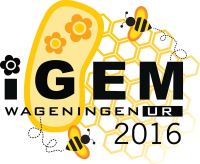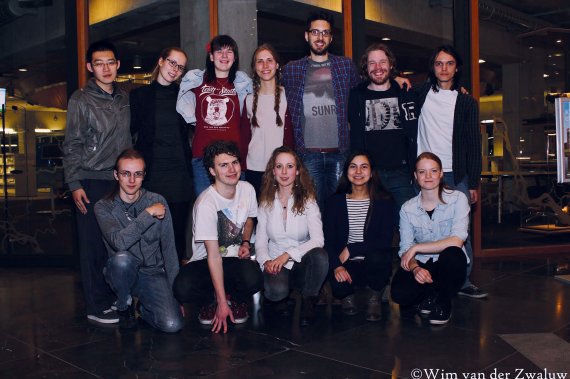Photo: Wim van der Zwaluw. The Wageningen iGEM team 2016 wants to use a specially equipped bacterium to tackle the varroa mite. This mite causes bee deaths.
The varroa mite is one of the key causes of bee deaths. At present, oxalic acid, formic acid and thymol, for example, are used to tackle the mites. This treatment has to be very accurate, says Thomas Swartjes, a Molecular Life Sciences student and captain of the Wageningen iGEM team. ‘Too high a concentration harms the bees. So the trick is to apply the right concentrations. The dosage has to be precisely right.’
But most beekeepers do it as a hobby. They don’t always take the time to follow the protocols precisely, or they underestimate the importance of the right concentration. So it would be good to have an alternative method, says Swartjes. The iGEM team are therefore taking a totally different approach. They are applying a form of organic pest control by equipping the model bacterium E. coli with a poison that specifically kills mites. The bacterium is then let loose in the hive as a kind of mite buster.
The poison ‘donor’ is Bacillus thuringiensis, a bacterium that creates protein-based toxins that are poisonous for many insects. ‘It seems as if one of these toxins specifically kills mites,’ explains Swartjes. The team wants to insert these genes in E. coli and let it loose on the bees, for example by adding the bacterium to the sugared water fed to bees.

The iGEM team has been together since last October. They have temporarily suspended their practical activities while the participating chair groups relocate to Helix. They are using that time to focus on the social side of the story: crowdfunding. Swartjes thinks they would need about 30,000 to 40,000 euros for the entire project. The Systems and Synthetic Biology group and the Microbiology group are contributing 10,000 euros. They will soon be calling on the ‘crowd’ for the rest of the money.
The project has to be finished by mid-October. If the team makes the finals, it will be travelling to Boston at the end of October for the final round. Two years ago, Wageningen came second (see box). The university was unable to put a team together last year. The current team consists of twelve Bachelor’s and Master’s students, evenly split between men and women.
(No) solution to banana disease
Two years ago, the Wageningen team came second in the iGEM biology competition with its ‘Banana Guard’entry. The students developed a soil bacterium that tracks down and kills the mould Fusarium, which causes the notorious Panama disease. Unfortunately, not much has been done with this since then, says PhD candidate Nico Claassens who assisted the group. ‘Some work was done on a small scale with a view to a publication, but even that didn’t work out. The project basically kind of petered out.’ According to Claassens, this often happens with iGEM projects. ‘People spend six months working intensively on it but then a lack of funds prevents them from continuing. The projects are testing the water but the road to an application is long and complicated. An added issue is that all entries are opensource. Everything belongs to everyone and that makes it difficult to start a company. You can’t patent the entry. So the projects often remain stuck at the nice idea stage.’

